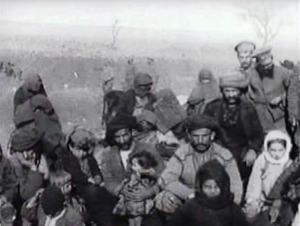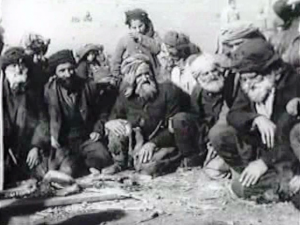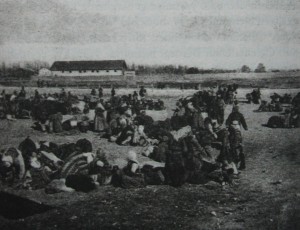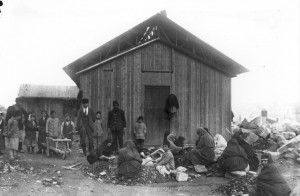The Other Side of the Coin in the 1915 Events: Muslim Refugees
The year 1915 was a time when great civil losses took place in the Caucasia battlefront. All parts of the society: Muslim, Christian, Turkish, Armenian, Cherkes, Kurdish, Arab, villager, city-dweller, rich-poor, experienced extreme grievances. Hundreds of thousands of people living in Ottoman provinces in the border regions died because of the bloody assaults by guerrillas or bad living conditions. A vast majority of those staying alive had to migrate to different places, leaving their homes. The region was almost completely evacuated. Families were dispersed and villages, towns, and cities were destroyed.
Armenians were subjected to obligatory migration by a law passed on the grounds that they cooperated with the Russians (Düstur 1336, p. 609). Muslims had to escape as they were attacked by occupying Russian forces and Armenian groups. However, the approach of the scientific world and political circles to these two obligatory migration movements, which took place in the same geography and almost one within the other, unfortunately is an exact example of double standards. The obligatory migration of Armenians was featured even from the beginning, researched as to the smallest detail and kept up to date with intense discussions; while the migration calamity of Muslims was overlooked and completely ignored. Cemal Pasha drew attention to these double standards in his memoirs published in 1920 (Cemal Pasha, 1996, p. 372-373):
“The murders that I heard to be done during the 1915 deportations are worthy of hatred. However…the scene of Kurdish and Turkish immigrants who migrated to Konya through Aleppo and Adana from Diyarbakır and from Erzurum and Erzincan to Sivas to be able to escape from Armenian torture and murders during the Russian invasion is not any less miserable. No German or American missionaries wrote reports about these wretches and felt the need of telling their calamities and miseries with a literal language as they were Muslims.”
This understanding which unfortunately continues to exist today as well causes a wrong judgment that only Armenians suffered during the war and Turks were only responsible for this. This perception, which became an issue of belief with the accustomedness of the years, prevented the normalization of Turkish-Armenian relations and became the main obstacle for peace and cooperation.
As opposed to the ignorance of the political and scientific world, even today the number of those who know the migration of Muslims and their painful memories is not small at all. These memories have been told from generation to generation in village rooms and have come until today. Those who joined in this migration known as helter-skelter or immigration were recorded in the official documents of the state as “people who migrated to surrounding provinces from war regions” or those who migrated to nearby regions from Van, Erzurum, Bitlis, and Trabzon regions.” Later on, they were called Refugees of Eastern Provinces to differentiate them from refugees escaping from the Izmir region due to the Greek invasion.
The touching conditions of Muslim refugees started to draw attention starting from the first days of the war (Hafız Hakkı Pasha, p. 95, 100; İlter, 2007, p. 15), but the actual big migration took place in two phases depended on the development of Russian occupation. In the first phase, the Van region’s people who were exposed to the Russian occupation in April of 1915 started to migrate, and later on the people from Erzurum, Erzincan, Bitlis, and Trabzon, which were occupied starting from the beginning of January 1916, also had to share their hunger and misery. According to the explanation by the General Director of Immigrants Hamdi Bey, the number of Muslims was around one and half million (Meclis-i Ayan Zabıt Ceridesi, Devre 2, 1991, p. 217). According to some estimations, it exceeded even one and half million (Tasvir-i Efkar, 11 May 1919, p. 2). This big refugee mass actually was the victim of the dream of an independent Armenia.
According to the Ottoman official population statistics in 1914, Armenians were less than the 20% of the population in the Eastern provinces (Arşiv Belgeleriyle Ermeni Faaliyetleri, 2005, p. 609). This demographic structure was a big obstacle before the establishment of an Armenian state in Ottoman lands and its continuation. However, Armenian groups were thinking to eliminate this obstacle by taking advantage of the war conditions. Their methods were simple and cruel as well. There would be ethnic cleansing. The Muslims captured would be killed regardless of being children, elders or women and the massacres would be carried out through terrifying methods. Therefore, terror would spread and other Muslims would be forced to leave the region.
Especially the Voluntary Armenian Troops guiding occupying Russian forces massacred many innocent people in many villages and towns that they burnt and destroyed with such thoughts. This terror demonstration by them was reflected in one of the reports of that period as “The guerrilla groups were proceeding by looting the properties of Muslim villages that they were passing through and killing everybody including the babies in cradle. Women and children hearing about their villainies left their houses and escaped” (Arşiv Belgeleriyle Ermeni Faaliyetleri, 2005, p. 411).
The Czar government, whose real intention was to take Anatolia under its own rule without leaving it to the Armenians, on the other hand, was planning to colonize the Ottoman lands that it occupied by placing Don and Kuban Kazaks here (Uras, 1987, p. 626-627). The wipe-out of Muslims by Armenians was a satisfying development to open the way for a colonization project for the Russian politics having such a hidden agenda. For this reason, instead of preventing Armenian attacks, they were encouraging people to escape by often saying “Run! Run! Armenians are coming; they will slay you as well.” (Ermeniler Tarafından Yapılan Katliam Belgeleri, 2001, p. 17).
American missionaries who were close friends of the Armenian rebels were also watching the escape of Muslims in full satisfaction. Miss Knapp, who was one of them, evaluated the coming of bloody-minded Armenian groups as a glimmer of hope and watched with pleasure from a high housetop the escape of defenceless women and children from them towards the sailing vessels in Lake Van (Brayce-Toynbee, 2005, p. 491). As she was a close friend of the raving rebels, Miss Knapp most probably knew that these poor people in the sailing vessels to go to Tatvan were going to be killed by being submitted to the guerrillas by Armenian boaters in a few hours (Demiroğlu, 1985, p. 64).
Tumbrels and draught animals were the only transportation means of the region. As a significant number of them were taken in the service of the army because of the needs of the battlefront, there was almost nothing for transportation with people. For this reason, the migration corteges trying to escape the guerrillas had to pass the unending mountains, plains, and valleys on foot. As the youth were in the army, there were only women, elders, and children in the corteges. Worn out families had to leave their elders, sick family members, and children who were not able to walk anymore to be able to continue their way (Sezen, 1999; Yaşar Kemal, 1999, p. 15-33).
Folk poet Ercişli Davut, who migrated to Urfa with one of these corteges, said these lines for the mothers and fathers left behind (Türkoğlu, 2000, p. 13):
Don’t think this miserable Davut has no pain
Don’t care about this mortal world in vain
Leaving Erciş is not the grief; yet
Elder mothers and fathers are left
Şevket Sürayya Aydemir, who was a young military officer at the time, witnessed the miserable conditions of these groups and recorded their conditions in history with these descriptive words (Aydemir, 1987, p. 84-85):
“The tumbrels are completely full in immigrant corteges setting off as crowded masses. Cows, horses, donkeys and even sheep flocks join them. People of a village always want to travel altogether. They try to continue their life orders they are accustomed to within the same people, same bonds and same hierarchy. However, it doesn’t take long that the cortege is fragmented and the crowd becomes lessened. First sheep flocks are lost; because the way is not forage. When the flocks are separated to the forage from the way, it means that the animals are out of hand. Hungry ones, runaways and bandits destroy them. Also not only the flock but also the shepherd goes… Then horses and cows go off hand. Those who die, get sick or change roads… When even a month didn’t pass since they left the village, that lively and healthy cortege becomes miserable remainders and ruins. “
After these general detections, Aydemir talks about a refugee family he came across in Suşehri and expresses how the migration tears hearts apart (Aydemir, 1987, p. 85-86):
“While we were looking for an empty place for each other in the darkness of the night, we heard a touching voice singing from behind the garden fence next to us. This voice was an incredible thing in this misery. The person singing this must have been an old woman. We went around the fence. An immigrant family had settled under a big mulberry tree. Oxen were at the other side. There were carpets felts laid on one side of the tumbrels. There was a light fire in the middle. There were two worrying human faces appearing in the shades lightened by this fire. One of them was a tired old man. The one who was singing was the grandma next to him. The grandma had given herself to the harmony of that strange song by hitting her hands on her knees like drumming and swaying right and left. She was crying. The tears dropping from her eyes had wetted her chest. What she was singing was not a song. I saw that night the first time that women in Eastern Anatolia cry like singing but I saw it a lot later on… What she was trying to say with music was their painful adventure. Homeland left behind, distances covered, unending roads, lost children, sick cow, dead goats, wasting food, loneliness, hopelessness, and everything else were being sung in this voice.”
While those who managed to get themselves to the provinces behind the battlefront were hoping to be saved, they were exposed to severe hunger and misery, which were taken maybe more heavily than death (ATASE Archive, Kls. 1131. Dos. 77. F. 12, 12-4; Köse, 2000, p. 785-792). The government who had not still completed the placement and employment of 350 thousand immigrants coming after the Balkan defeat (Meclis-i Ayan Zabıt Ceridesi, Devre 3, 1991, p. 215) was helpless before this big migration wave. Even so, they were sent to the inner parts of the empire for their needs to be met more easily and they were made to spread in a more wide area. Therefore, immigrant corteges escaping from the Armenian guerrilla groups spread all around Anatolia. Some of them went to Aleppo and Mosul, today’s lands of Syria and Iraq (BOA, DH. İ UM, Dos. No: E-15, Doc. No: 54).
As they had to leave all they had when they were leaving their homes, they were in need of everything needed for a living, including accommodation, food, clothes, land to be plowed, animals to plow the land, seeds etc. However, only very little of these needs were able to be met unfortunately. No matter how the government expresses that 70% of them were employed in the sectors of agriculture, trading, and industry and they were able to earn their livings (Meclis-i Ayan Zabıt Ceridesi, Ankara 1990, p. 206-208), the reports coming from the provinces showed that they were still hungry, miserable, and wretched (BOA, DH. İ UM, Dos. No: 6, Doc. No: 2; Dos. NO: 20-2, Doc. No: 2-7; İkdam, 28 September 1918, p. 2). Many of them were put in mosques, madrasahs, and barracks though it was against health and moral rules. Although barracks, piers, station buildings, factories, and bakeries were used for this purpose, the number of those who were hungry and homeless in streets and tried to live in caves was not small at all (TBMM Zabıt Ceridesi, 1958, p. 421; Temel, 1998, p. 82-94).
About 350 thousand immigrants who were not in a position to work were given daily-wage (Meclis-i Ayan Zabıt Ceridesi, 1990, p. 206-208, 217-218). This daily wage, which was 1.5 kurus in the beginning (TBMM Zabıt Ceridesi, 1941, p. 19) and then raised to 3 kurus, did not actually have a value. Durak Bey from Erzurum deputies expressed what the daily wage was equal to by these striking words he uttered in the assembly stand: “What can be bought with 3 kurus today, sirs? They give hemp to a person for 3 kurus, they smother him and they give nothing else.” (TBMM Zabıt Ceridesi, 1961, p. 257). Furthermore, even these wages were sometimes not being paid for months (BOA, DH. İ UM, Dos. No: 4-1, Doc. No: 1-47; Dos. No: 4-1, Doc. No: 38; Dos. No: 20-2, Doc. No: 2-7; Dos. No: 1-3, Doc. No: 1-14). The immigrants who mostly had to take care of themselves under these conditions were really in a miserable condition. There are many documents reporting their miserable conditions in Ottoman archive records. A historical telegraph sent from Urfa on 16 February 1918 among these documents informed that immigrants from Erzurum, Van, and Bitlis in Urfa were dying of hunger (BOA, DH. İ UM, Dos. No: 20-2, Doc. No: 2-46):
“People die every day because of hunger. Those who are wandering as living corpses are also fed up with life. Many people cannot find anything to eat though they wander around the neighbourhoods to be able to find even one piece of bread. 80% of miserable mothers who run to the butchers and slaughter houses to find garrotted sheep flesh with the hope of saving the lives of their children who cry out because of hunger are coming empty-handed. Some of them are trying to stay alive with the animal carrions they can find. Though the countryside people are running here and there to be able to crop like animals, it is not possible for them to find anything in this season.”
The situation was not different in other places as well. The rate of death was quite high due to malnutrition, more precisely hunger and bad living conditions. Though we don’t have accurate numbers, more than 40% (around 700 thousand people) of the immigrants died because of the attacks they were exposed to or hunger and misery they had to face in the places they took shelter in as far as it is understood from some records of 1919 (BOA, DH. SN.THR, 82/55, Lef. 48; Tasvir-i Efkâr, 11 May 1919, p. 2). On the other hand, the death rate among Armenians deported was much lower and it was around 15% (Lewy, 2011, p. 345). Armenian deportations, despite all of its flaws, were carried out under the control of the state and within a certain plan. Also, while Armenians being deported were helped and supported by American missionary organizations, no foreign aid was supplied to Muslim immigrants except for some exceptional cases (Gencer, 206, p. 71-148).
The duty of scientists, politicians and people with conscience now is to leave the old accustomedness aside and, instead of reading the 1915 events only from the Armenian deportations, to take a glance at the other side of the coin and take a decision after trying to understand the sufferings of Muslim refugees.
Bibliography
Archive Documents
ATASE Arcive, Kls. 1131. Dos. 77. F. 12, 12-4.
BOA, DH. İ UM, Dos. No: 1-3, Doc. No: 1-14; Dos. No: 4-1, Doc. No: 38; Dos. No: 4-1, Doc. No: 1-47; Dos. No: 6, Doc. No: 2; Dos. No: 20-2, Doc. No: 2-7; Dos. No: 20-2, Doc. No: 2-46; Dos. No: E-15, Doc. No: 54.
BOA, DH. SN.THR, 82/55, Lef. 48.
IRCICA Archive Nr. 6070.
Published Documents
Arşiv Belgeleriyle Ermeni Faaliyetleri (1914-1918), I, Ankara: Genelkurmay ATASE ve Genelkurmay Denetleme Başkanlığı Yayınları, 2005.
Düstûr, Tertib-i Sani, VII, Dersaadet 1336.
Ermeniler Tarafından Yapılan Katliam Belgeleri, I, Ankara: Başbakanlık Devlet Arşivleri Genel Müdürlüğü Yayını, 2001.
Meclis-i Âyan Zabıt Ceridesi, Devre 2, İçtima Senesi 4, Book II, Ankara 1991.
Meclis-i Âyan Zabıt Ceridesi, Devre 3, İçtima Senesi 4, Book I, Ankara 1990.
Meclis-i Âyan Zabıt Ceridesi, Devre 3, İçtima Senesi 4, Book II, Ankara 1991.
TBMM Zabıt Ceridesi, Devre 1, İçtima Senesi 1, Book III, Ankara 1941.
TBMM Zabıt Ceridesi, Devre 1, İçtima Senesi 2, Book X, Ankara 1958.
TBMM Zabıt Ceridesi, Devre 1, İçtima Senesi 4, Book XXVIII, Ankara 1961.
Newspapers
İkdam, 28 September 1918.
Tasvir-i Efkâr, 11 May 1919.
Books and Articles
Aydemir, Şevket Süreyya (1987), Suyu Arayan Adam, Istanbul.
Brayce, James-Arnold Toynbee (Ed.) 2005), Osmanlı İmparatorluğunda Ermenilere Yönelik Muamele 1915-1916, II , trans. A. Tuygan-J. Değirmenciler, Istanbul.
Demiroğlu, Faiz (1985), Van’da Ermeni Mezalimi (1895-1920), Ankara.
Gencer, Fatih (2006), Ermeni Soykırım Tezinin Oluşum Sürecinde Amerikan Yakındoğu Yardım Komitesi, Istanbul.
Hafız Hakkı Paşa (2014), Hafız Hakkı Paşa’nın Sarıkamış Günlüğü, prep. Murat Bardakçı, Istanbul.
İlter, Aziz Samih (2007), Birinci Dünya Savaşı’nda Kafkas Cephesi Hatıraları, prep. Zekeriya Türkmen-Elmas Çelik, Ankara.
Kemal, Yaşar (1999), Yaşar Kemal Kendini Anlatıyor-Alain Bosquet ile Görüşmeler, Istanbul.
Köse, Osman (2000), “Birinci Dünya Savaşı Yıllarında Canik’in İaşe Durumu (1914-1918)”, Belleten, LXIII/238 (Aralık 1999), Ankara, p. 785-792.
Lewy, Guenter (2011), 1915 Osmanlı Ermenilerine Ne Oldu?/Çarpıtılan-Değiştirilen Tarih, trans. Cilt Elitez, Istanbul.
Malmîsanıj (2002), Kürt Talebe-Hevi Cemiyeti/İlk Legal Kürt Öğrenci Derneği, Istanbul.
Sezen, Yıldırım (1999), İki Kardeşten Seferberlik Anıları, Ankara.
Temel, Mehmet (1998), İşgal Yıllarında İstanbul’un Sosyal Durumu, Ankara.
Türkoğlu, Salih (2000), Vangölü Rüzgârı: Van-Bitlis-Adilcevaz-Ahlat-Bahçesaray-Erciş-Muradiye-Tatvan, Van.
Uras, Esat (1987), Tarihte Ermeniler ve Ermeni Meselesi, Istanbul.
Categories
- Experience of Living Together of Turks and Armenians
- Demographic Structure of Armenians in the Ottoman Lands
- Disturbances in Anatolia: Protests and Anarchy
- Armenians and the International System: Seeking a Solution
- Historiography in Turkish-Armenian Relations
- Dispatchment and Settlement: Discourses of Genocide
- Trials and International Law
- Armenians in Society and Bureaucracy
- Armenian Diaspora
- Church, Identity, and Social Structure




